 |
surfresearch.com.au
renwick : okinuee, 1957 |
Renwick, Ross: Build yourself an okinuee board.
Australian Outdoors
November, 1957, pages 16 to 21.
| home | catalogue | history | references | appendix |
 |
surfresearch.com.au
renwick : okinuee, 1957 |
Build
yourself an okinuee board
They're
all the rage this surfing season!
The
Hawaiians introduced them to Australia last year, and they
caught on fast.
They're
easy to make, too!
It was late
on
the afternoon of Sunday, November 10, last year, at Avalon
Beach in N.S.W.
An international
surf carnival had just drawn to a fairly drab finish, with
teams from America,
South Africa, New Zealand; Ceylon, Hawaii and Australia
competing.
Most of the
crowd
had left.
A few
stalwarts
stayed to watch the Hawaiians take their peculiar little
surfboards out
through the mountainous seas.
The boards
were
short - 6 ft. shorter than our own 16 ft. boards; and they
were wider -
25", compared to 19" or 20".
Instead of
being
made of hollow plywood construction they were carved from
solid female
balsa.
Over the balsa was a thin fibreglass coating.
Opposed to
our
finless 16 ft. boards they had nine inch fins placed about
two inches from
the tail.
These fins were very similar in shape to the dorsal fin of a
shark.
They were as
different from the popular Australian surfboard as they
possibly could
be.
All who
watched
were sceptical.
Earlier they
had seen crack Hawaiian waterman, Tommy Zahn, reputed to be
a former beau
of Marilyn Monroe, compete disastrously in the surfboard
race.
Zahn was
winner
of a 26-mile board race in Hawaii and was paddling the same
board in the
race at Avalon.
It was 15
ft.
long and similar in shape to one of our racing skis.
Over its
frame
of balsa was stretched light canvas which was impregnated
with fibreglass.
A rudder,
operated
with the feet from the lying position, steered it.
Zahn, a
tremendous
figure of a man, paddled out through the 15 ft. sea lying
down.
Rounding the
buoys and back into the wave area, he lay fifth in a field
of top Sydney
board paddlers. On the front of a big wave the nose of his
board dug in
and he disappeared into the break.
When he
surfaced
his board was smashed beyond repair, slit from end to end.
Amused
Australians,
confident of their own surfting prowess, and fed on the
legend of small,
rolling surfs at Waikiki Beach, nodded condescendingly and
said, "Knew
these boys couldn't handle our big, steep waves".
Avalon had
really
turned it on that day.
A surfboat
guarding
the swimming buoys, and supposedly 150 yards outside the
danger area, had
been hit by a huge wave and swamped, injuring some of the
crew.
Only a
handful
of competitors in the board and ski events had negotiated
the break successfully,
and eventually there had been more swimmers in the board
race than there
had been in the surf race. Few of those who threaded their
way through
the waves on the way out managed to get back to the beach
still attached
to their boards.
In the R.
and
R. event the Hawaiian beltman had failed to reach the buoys.
In surfing
circles
this is the greatest disgrace of all.
Hawaii's
stakes
were low that day.
Now they
were
taking their little balsa surfboards out through the rip in
the centre
of the beach.
A balsa
surfboard!
Very little
lateral
strength!
The thin
fibre
glass covering kept water out of the porous wood, but added
very little
in the day (sic, way) of durability.
Ten feet
long,
or less - not 16 like our own "tooth- pick" boards.
Their twenty
pounds weight was too light for Australian conditions!
Or so we all
thought.
So on the
beach
were about 200 very sceptical, slightly tolerant
Sydney-siders.
Watching the
long, ...
Page 17
... steep
escarpments
of water roll past them were a handful of Hawaii's best
surfboard riders
- not men from placid Waikiki Beach - but from the beaches
of Sunset and
Makaha on the other side of the Island of Oahu.
Beaches
where
the long Pacific swell sometimes rose to an awesome
thirty-five feet before
crashing on to the submerged bombora reefs hundreds of yards
off- shore.
These men
were
used to cracking waves of immense size, cornering their
boards parallel
across the face of the wave and flying, at bullet-like
speed, out into
the calm water on either side.
They could
"zip"
and throw their boards about in a manner Australians,
handicapped by 16
ft. of heavy wood, thought impossible.
First man
on to
a wave was Mike Bright.
Paddling
lying
down, he pushed on to a fifteen foot wave off the baths at
the south end
of Avalon, straight in front of the rocks.
Bright spun
his
board into a corner and in a flash was travelling in a
"parallel zip" across
the face of the wave, heading for the smooth rip water 150
yards away.
The crest
was
curling over him as he shot into the rip and fiicked his
board over the
top of the wave and back out to sea.
Bright had
cornered
150 yards across the front of the wave in 6 or 7 seconds,
during which
time the wave had made very little progress in a shorewards
direction.
Australians on the beach were stunned again and again as the Hawaiians shattered the popular theory that short boards were not good on big waves, and when they finished an hour later not a person had left the beach.
POWER TO
POWER
CORNERING
After the
carnival
I spoke to Greg Knoll (sic, Noll) of the American
surf team, who
said that fifty miles per hour or over was usual in a
parallel corner on
a 15 ft.-plus wave with those boards.
This
involves
what is known as "power-to-power" cornering.
"Power-
to-power"
means the power of the forward motions of the wave, exerted
on the "sideways
falling" motion of the surfboard.
In a normal
comer
this gives the speed of the wave, plus 50 per cent, as the
actual speed
of the corner.
But both
these
factors may vary, particularly the latter - the 50 per cent
- which is
actually the "power-to-power" factor.
The speed of
the wave can vary only within certain limits, but the
"power- to-power"
factor can be constantly changing.
For
instance,
a big southerly sea has good cornering characteristics.
The waves
are
usually not very long but have high peaks, about 20 yards
wide, which break
first. Catching the waves at one of these peaks, the board
is hurled down-wards
as the peak jumps before breaking.
This
original
impetus can add much to the power-to-power ratio.
The Hawaiians demonstrated this at Avalon, where the 16 ft. surfboard lost its glamour position in the ,Australian surfing scene.
INTRODUCTION
OF
SURFBOARD RIDING IN AUSTRALIA
How did this
type of surfboard, which was fairly unsuitable for riding
waves, come to
be accepted by surf-loving Australians?
The trend
away
from good wave boards was started by the champion surfboard
racers of recent
years, who found that the longer, thinner boards were
faster.
Speed
compensated
for loss of manoeuvrability on a wave, and because these men
were all stars,
the general
run
of board riders followed the fashion they set.
However,
many
types of board had been seen on the Australian coast in the
30 odd years
before these came into vogue.
Surfboard
riding
was originally introduced into Australia by an Hawaiian,
Duke Kahanamoku.
Riding the
waves
in Hawaii goes back a long, long time, and many native
legends involve
cracking waves in j or on a various assortment of crafts
(sic, craft).
The Hawaiian
Commercial Advertiser ...
Page 18
... of
April 2,
1868, reports what it describes as "the greatest aquatic
feat in the world".
The hero of
the
story is a man called Huloua, who lived near Ninole, on a
big island of
Hawaii.
On this day
tidal
waves struck the island and Huloua and his wife fled to the
hills.
But Huloua
remembered
he had left his money behind, so he dashed back to his
house, which sat
in the path of the first of the giant waves.
The wave
struck
the house and the angry waters sucked it out to sea with
Huloua still inside.
Miles out to
sea, but undaunted, Huloua wrenched a rafter from the
ceiling (he was a
powerful man) and rode the next wave - a mighty 60-footer -
to the shore,
landing on a hillside where his wife awaited him.
The wave he
rode
is reported to have wiped out four villages and killed over
one hundred
people. With this story in mind, not many would dispute that
Huloua is
the grand daddy of all surf riders, and a good man on a big
wave to boot.
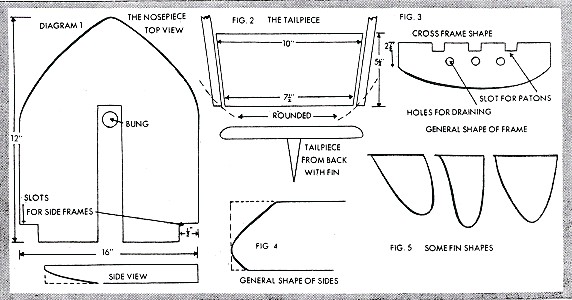
Duke
Kahanamoku,
who could be described as a more modern Huloua, was here in
the summer
of 1915, fresh from Olympic swimming triumphs.
When the
Duke
arrived Australians had mastered only the art of body
shooting.
Nothing
successful
had been done on a board, although a few attempts had been
made to master
the tricky sport.
Kahanamoku
carved
a huge lump of Australian sugarpine into the shape of a
surfboard, 9 feet
long, 25 inches wide and weighing 95 pounds.
When he had
finished
the board he promised the locals at Freshwater an exhibition
one Saturday.
On the day
the
Duke was accompanied by three Australian board riders, Geoff
Wylde, "Busty"
Walker and Claude West.
All four
left
the beach together, but the Duke had caught four waves
before any of the
Australians got out, and when they did, they saw Kahanamoku
standing backwards
and waving to them as he disappeared shorewards on a huge
wave.
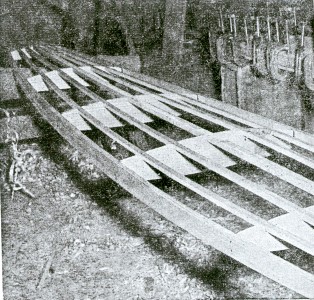 |
Note the cross frames supporting four horizontal stringers (sic, five longitudinal?). The cross frames are for general frame strength, while the stringers support the ply. |
Kahanamoku
impressed
that day with his skill and daring, a new aspect of surfing
was revealed.
The
possibility
of riding the waves on a piece of wood had seemed remote
before, but was
now very feasible.
The movement
towards surfboards in Australia had started.
When
Kahanamoku
left, West, Wylde and Walker started experimenting in shapes
of boards
and techniques of riding the waves.
They were
joined
by others and a number of solid boards were constructed.
These boards
varied from 6 ft. (minimum) to 9 ft. 6 ins. (maxi- ...
Page 19
... mum)
and weighed
upwards of 75 Ibs.
The board,
which
hardly floated at all, were pushed on to many a fine wave
and Australian
surfboard riders became known among the best in the world.
But these
solid
boards floated low in the water - in most cases completely
under the surface
- and it was a strong man who could push his board on to a
wave before
the wave broke.
It was
tremendously
hard to get them out through a big sea, but once on a wave,
they gave an
"armchair" ride.
But catching
the waves in dangerous spots such as bomboras, where one
mistake on the
part of the rider or an inadequacy in the design of the
board could mean
possible death, these boards were useless.
So just
before
the war, when Fitz Lough started building hollow boards,
things really
began moving. Lough was the pioneer of hollows and built a
board 11 to
12 feet long and curled up at the front like a snow ski.
Waves could
now
be caught much farther out then before and every aspect of
board riding
was made simpler.
Boards
floated
higher, became longer, and acquired more glide.
A new era
was
beginning.
Down south
at
Maroubra a strong board movement was growing led by Lew
Adler, and it was
from here that many champion board riders came.
Also
building
"hollows" was Fred Hoinville of Bondi, who organised the
since discontinued
Australian Surf Board Association.
Hoinville
built
a parallel-sided board - dreadful on any waves, big or
small.
It was about
this time, just before the war, that a noticeable evolution
away from good
wave boards began.
The
champion paddlers
in board races found that a deep-sided hollow board, which
was more buoyant,
could get out more easily.
Boards
became
longer but narrower - first 14 ft., then 15, then 16.
After the
war
a new crop of surf-minded Australians inherited the long
boards.
There were
still
brilliant riders.
Men like Bob
Evans of Queenscliff and Roger "Hellfire" Duck of Manly
cracked the awesome
North Steyne bombora (sic, more commonly known as the
Queescliff Bombora),
while "Bluey" Mays of Bondi threw his board about in
hurricane seas.
But the
sixteens
were still difficult boards to handle well, and the number
of very good
riders was limited.
With the
evolution
away from these long boards comes one big advantage -
manoeuvrability.
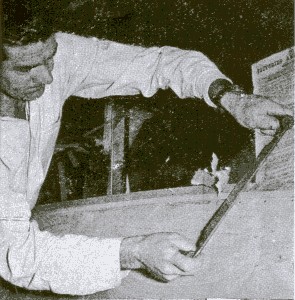
Gordon Woods using a spokeshave to round the sides. |
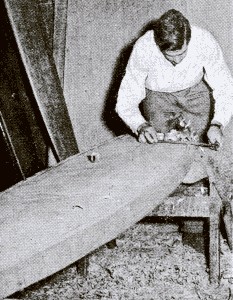
Rounding the sides of the board is a fairly important job, and takes some time. |
MAIN APPEAL
OF
THE SHORT BOARDS
The main
appeal
of the Hawaiian- type board, apart from manoeuvrability,
lies in the fact
that it has facilitated a previously difficult facet of the
sport - cornering.
Cornering
means
traversing across the face of the wave along the beach
instead of towards
it.
When the
wave
is about to break the board is straightened so that it can
be ridden through
the white water and up to the beach.
The
straightening
of the board can be extremely difficult for the sixteen
footer, and at
best, takes a matter of seconds.
An Okinuee
can
be flicked through a ninety degree turn and straightened
even while the
wave is curling over the board.
Alternatively
it
can be flicked up and over the wave and back out to sea
again before
the wave breaks.
STANDING
POSITION
ON BOTH BOARDS
On a sixteen
foot board the standing position varies from about 4 ft.
from the back
of the board on a small wave to a matter of inches from the
back of the
board on a large wave.
This means
that
the rider has between 12 and 15 feet of board in front of
him to control.
Particularly
in a large surf there is always the danger of the board
digging into the
front of the wave or becoming uncontrollable.
At increased
speeds in corners this foot- age builds up air-resistance
and fans up and
down in an alarming manner.
As a sixteen
footer has high flat sides which will not settle into the
wave it is comparatively
slow in corners.
Also, as
mentioned
before, difficult to straighten up when the critical
"breaking" time comes.
On an
Okinuee
the legs are placed farther apart and the normal standing
position is very
little distance behind the centre of the board.
In a
position
between three and four feet from the tail (which is only 6
feet from the
front) the board can be swiftly turned and easily controlled
in a parallel
corner.
The whole
side
of the board "grooves" into the wave and extra speed is
obtained by moving
towards the front.
On big waves
the front foot can be as close as two feet from the very
front of the board
- in complete ...
Page 20
...
contrast to
the 16 ft. board.
In the
coming
season Australians will be thrilled and amazed by the
spectacles created
by these new Okinuee boards.
A HOLLOW
HAWAIIAN
BOARD?
After the
Hawaiians
had impressed everybody with the shape and design of their
board a problem
presented itself to the board builders in Sydney - balsa.
The Hawaiian
boards were solid balsa - 10 feet long, 2 feet wide, and
from 4 to 6 inches
deep.
This much
balsa,
if it were available ; would have cost £60 in Australia.
With no
other
wood as suitable a number of experiments took place with
hollow boards.
The
intention
was to copy the shape and fiotation of the solid balsa
Hawaiian board.
Douglas
Jackson
and David Lyall of Bilgola Surf Club were the first to
launch a short
board.
Their boards
were about eight feet long, looked and fioated like a door,
but were good
performers on a wave.
They were
hard
to get out and the corners of their square front constantly
dug into the
water.
Sitting out
the
back waiting for waves was both an un-nerving and cold
pastime as the board
floated about six inches under the water.
But in a
corner
they were fast, though not as fast as a balsa board, and
they were manoeuvrable
enough to be very encouraging.
Then a
month after
the Hawaiian surf team had gone home well-known board rider,
Gordon Woods
of Bondi, turned out a beautifully moulded hollow board,
which at first
glance looked exactly the same as its balsa counterpart.
He had not
only
copied the shape, he had improved upon it in many respects.
Gordon had
bought
one of the three Hawaiian Balsa boards which were left here,
and studied
its shape carefully.
The board he
made was faster and had better flotation than the balsa one,
it would catch
a wave sooner and was not very much heavier.
Its
performance
on a wave was terrific, although the balsa board was a
little more comfortable.
Gordon had
proved
that an Australian-built 10 foot board, copying the Hawaiian
shape, was
comparable
with
the Hawaiian one.
So much so
that
he has already received two orders from Honolulu.
Ten feet was
found to be a good, all-purpose size, but a shorter board is
more manoeuvrable,
though slower to paddle.
And "slower
to
paddle" means that waves are harder to catch.
You'll have
to
decide for yourself what size suits you best.
Keep in mind
that only a few inches in length make a big difference.
| Then
a month
after the Hawaiian surf team had gone home well-
known board rider, Gordon
Woods of Bondi, turned out a beautifully moulded
hollow board, which at
first glance looked exactly the sarme as its balsa
counterpart.
He had not only copied the shape, he had improved upon it in many respects. Gordon had bought one of the three Hawaiian Balsa boards which were left here, and studied its shape carefully. The board he made was faster and had better flotation than the balsa one, it would catch a wave sooner and was not very much heavier. Its performance on a wave was terrific, although the balsa board was a little more comfortable. Gordon had proved that an Australian-built 10 foot board, copying the Hawaiian shape, was comparable with the Hawaiian one. So much so that he has already received two orders from Honolulu. Ten feet was found to be a good, all-purpose size, but a shorter board is more manoeuvrable, though slower to paddle. And "slower to paddle" means that waves are harder to catch. You'll have to decide for yourself what size suits you best. Keep in mind that only a few inches in length make a big difference. The three different
types of board mentioned in the story.
|
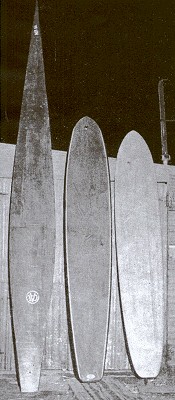
|
THE NOSE
BLOCK
The
nose-block
is made of three inch deep maple (see diag. 1).
The slots on
the side are for the side frames, while the slot down the
centre is for
draining and placement of the bung.
The
nose-block
is simply cut to shape, as in top elevation diagram.
Shaping of
under-side
is not done until the board is practically finished.
THE TAIL
PIECE
The tail
piece
is also made of three inch maple (see diag. 2).
There are no
slots in this section as the side frames fit around it, not
into it.
THE SIDE
FRAMES
These are of
three inch by 1/2 inch maple and their length determines the
total length
of the board. Using a waterproof glue, they are first glued
...
Page 21
... and
nailed
into the slots on the nose piece.
Then they
are
glued and nailed around the sides of the tail piece.
All nails
used
in the construction of the board must be copper.
When the
glue
has set the back corners of the tail piece are rounded.
By virtue of
the shape of the nose and tail block the board will now have
fallen into
shape, close to what it will be when it is finished.
Final shape
is
now determined by the placing of the cross- frames.
Four
cross-frames
for a 10 foot board should be enough.
The board
should
be thickest about four feet from the nose so the longest
cross-frame is
put in here. Total thickness, including i inch shaped side
pieces, should
be about 23 inches to 24 inches at this point.
The
cross-frames
are equally spaced along the board.
They have
slots
cut in the top of strengthening stringers, and are bored for
the purpose
of
drainage
(see
diag. 3). Three or four stringers may be used, and it is
recommended
that
they run the
whole length
of the board; that is, from the nose piece to the tail
piece.
They need
not
be very thick - certainly no more than ~ inch.
See photos
for
positions of stringers and frames.
These show
four
stringers but three will be enough for an average-sized
person.
THE PLYWOOD
.
The frame is
now ready for the plywood - 1/4 inch three-ply.
The top of
the
board is planed and the plywood is glued and nailed.
Plywood must
always be nailed from the centre to the nose, both sides
together - then
from the centre to tail.
The top ply
is
put on first so that the frame will not warp when the curved
bottom is
placed.
A hole for
the
bung is now drilled through the top ply.
It may be
left
as it is or a metal bung may be mounted.
ATTACHING
THE
BOTTOM
Because the
base
will be curved a slight angle must be planed on to the side
frames to receive
it neatly.
This angle
can
be checked by the cross-frames, as it will correspond with
them.
Nail again
from
the centre.
Excess ply
must
now be planed off and the frame and ply is ready to receive
the shaped
edge strip. This strip is , inch by three inch maple, and
must be glued
on.
If a sash
clamp
is not available it can be lightly nailed, the nails being
removed after
the glue is dry. When the glue is dry this strip is
shaped-by spokeshave
or plane - so that it is curved (as in diag. 4) with a
fairly sharp edge
towards the bottom of the board.
The
underside
of the nose is now planed (as in fig. 1) so that the front
of the board
will cut through the water more neatly and not throw a
spray.
Now all
that remains
to be done is to fix the fin about two inches from the tail.
The fin
should
be about 8 inches high and can be mounted with fibre glass,
as firmly as
possible (see diag. 5 for shape).
General
sandpapering
and varnishing or painting should now finish the board.
At least
four
coats of varnish or two coats of paint are recommended.
The board is
then ready.
Now it's up
to
you but keep in mind that only constant practise will make
you a board
rider.
Handling the
shorter boards is quite similar to handling the conventional
style board,
although there are a few variations.
One thing
the
rider will notice as soon as he mounts the Okinuee is the
increase in manoeuvrability
and speed.
He'll have
to
make a whole revaluation of his board riding technique.
He must
remember
not to sit so far back on the board that the nose is
completely out of
the water. The correct position is at that point on the
board where the
rider's weight just lifts the nose from the water.
As a wave
builds
up behind, give three or four very hard paddles, then slide
to the back
of the board, to keep the nose from digging in at the bottom
of the wave.
The best
place
for beginners to learn is in rips where waves sometimes do
not break.
They must
remember
never to learn in the vicinity of a sandbank for it is on
these sandbanks
that waves dump.
When you
decide
the time has come to stand up on the board, do so as quickly
as possible.
Don't try
and
balance on the way up.
Get to your
feet
and then worry about balance.
If you
happen
to falloff, make sure you go to the side of the board not to
the front.
And don't
forget
that oniy practice makes good riders.
| He'll have to
make a whole revaluation of his board riding
technique.
He must remember not to sit so far back on the board that the nose is completely out of the water. The correct position is at that point on the board where the rider's weight just lifts the nose from the water. As
a wave builds
up behind, give three or four very hard paddles,
then slide to the back
of the board, to keep the nose from digging in at
the bottom of the wave.
Without the fin,
the board will skid and skitter about in the
water.
|
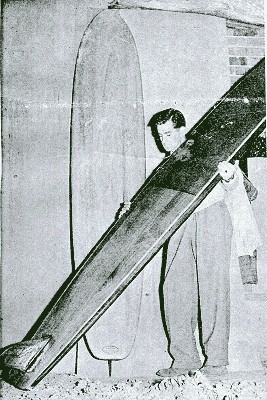
|
|
Australian Outdoors November, 1957, pages 16 to 21 . |
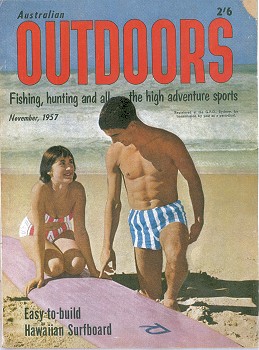 |

| home | catalogue | history | references | appendix |